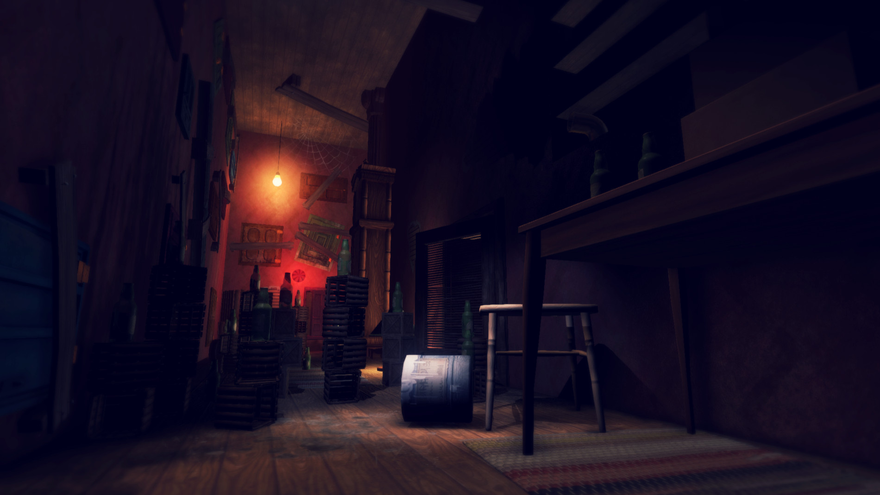The Norwegian forests were a frightening thing for Ole Andreas Jordet. As a child, he’d have to cross through them in order to return home from his friend’s, where he’d often lose track of time well into the night. Ole says his friend would have to call out from the lit porch to keep him from being petrified, to keep him moving through the dark. It’s those early fears which have bled into Among the Sleep, a horror game Jordet and Krillbite Studios have been stitching together about surviving a strange night as a defenceless toddler.
For Anders Ugland, the game’s lead designer, the game began with an image that’s been embedded in all of us from cartoons and boogiemen stories. “I had this vision of this child running down the stairs and hiding from a monster,” says Ugland, “and then everything was seen from a first-person perspective … We’ve had talks with the entire team where everyone told their childhood fears and nightmares. Such as darkness, it’s a big part of it all. It fits well with being vulnerable as a little child.”
When I was younger, videogames could terrify me. Well into my teens, I remember playing Fatal Frame belly flopped on a hardwood floor in an unlit living room, deep into a sleepless night. Contrast that to years later playing Dead Space, a space shrieker heralded as the future of horror games in which I received zero goosebumps from.

Sure, I, as Isaac, was isolated in the cold depths of the universe, odds stacked against me and surrounded by cosmo cult ultra-demons—but I was also equipped with a gun that shot anti-gravity remote control saw blades. I had the future on my side; I could turn my boogiemen into ribbons. I was having fun while not being scared. A lot of contemporary horror games, in the name of adrenaline, star the same kind of superheroes you’d find in titles less spooky.
“It wasn’t until we had worked a while with the game that we understood how well vulnerability works with this type of horror game,” says Ugland. “When Amnesia came out, we were working on Among the Sleep as our thesis project for school, and when we saw the same type of non-violent character, it really gave us a lot of confidence. Amnesia is a very good game. It helped push us toward the horror that it was today. It had a bit more adventure elements to it. We’ve definitely been discovering along the way.”
There are certainly horror survival games that have put you in the sneakers of an average, underpowered human being—notably Fatal Frame, Amnesia and some Silent Hills—but normally mood and action are elements that seem to bloody knuckle each other with every monster encounter. Among the Sleep pushes this concept into a weird, unexplored turf, dysmorphing the perspective into the paws of an infant. A helpless bundle that most adults would rather protect than willingly thrust into the night. Someone who is not known for high functions. Someone who cannot fight back.
“We used the toddler aspect as with what kind of elements we could play around with in horror,” says Jordet. “It’s more about you fearing what you don’t know. Especially with a child, who knows very little. With a child you can use that limited insight on our world, how it looks, as a more active part of the environment, the universe.”
Just like in Jordet’s childhood wildernesses, the darkness (and whatever mysterious monsters hide within it) is a huge intimidator to players of Among the Sleep. Dead Space’s BFGs aren’t here to help you; I’d be shocked if your protagonist could even hold any of them up. But you will have one comfort—a literal comfort object, a teddy bear that illuminates through hugs while acting as a speaking cohort through the weird world. A plush toy would appear as such to a child, after all.
You will be an adult consciously functioning through the eyes and body of a two-year-old. What narrator is more untrustworthy than one that simply doesn’t understand the world around them? Jordet and Ugland explained to me that the game’s dangerous world is a constantly changing one, and you cannot depend on the scale or form of objects to remain constant or coherent.

We’ve become accustomed to being masters of our surroundings in videogames, horror and otherwise. We’re used to the comfort that the survival part of survival-horror can win out, a balance that’s been thrown off by a trust we’ll be given devices and abilities to overcome even the gnarliest mutants. That big perks present themselves before big ghouls. I’m certain Among the Sleep won’t be unwinnable, but what more interesting a position to be thrown into than one of complete helplessness. Someone who, in real life, you constantly fear might walk into the edge of a table. To star in a horror-survival game as that target of concern.
What’s more frightening than being fragile?
“Too many horror games these days, and a lot of people are saying it, are just shooters with jump scares,” says Ugland. “I definitely think that vulnerability is a key. If you have it, you’ll be able to create a lot of more tension than just the fear of not knowing or how to defend one’s self. For Among the Sleep it’s very important.”
